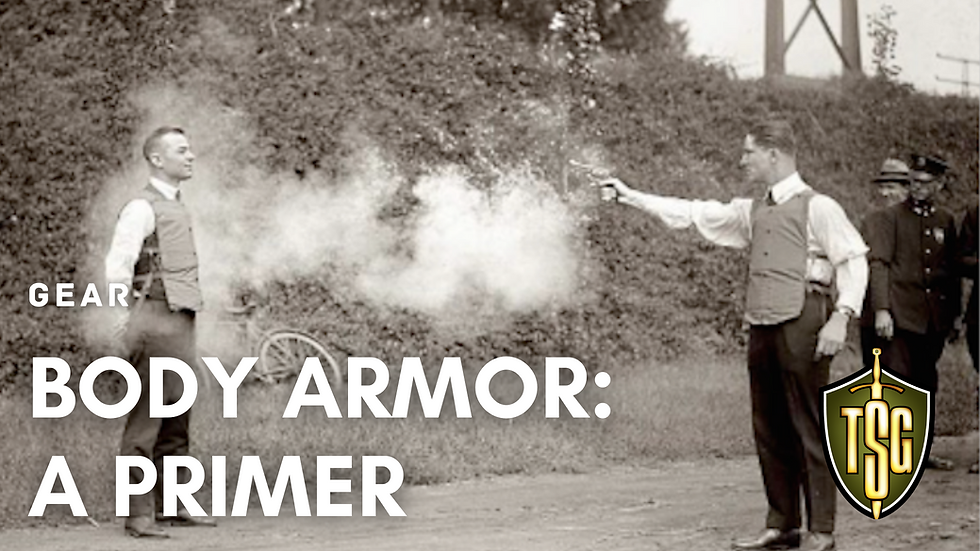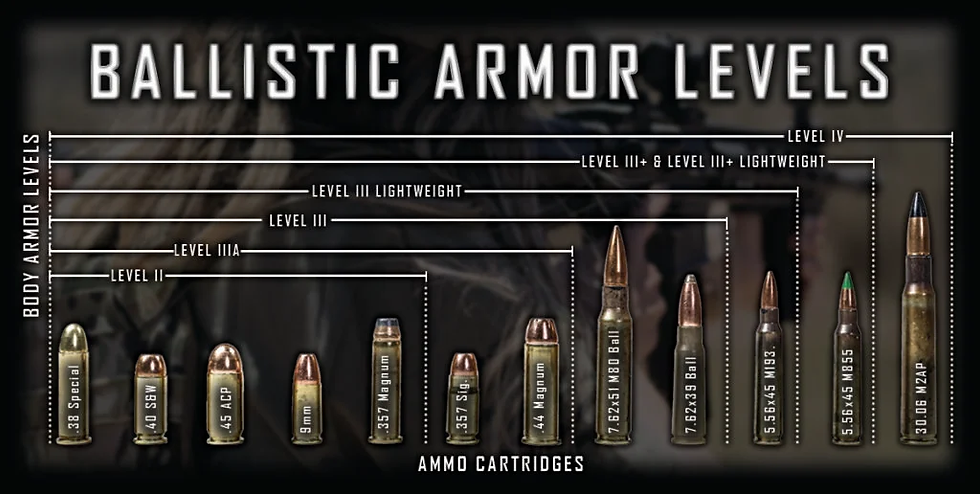Body Armor: A Primer
- Brad Parker
- Aug 2, 2020
- 7 min read

No matter how you look at it, firearms are dangerous. Their sole purpose is to propel a small piece of metal at hundreds or thousands of feet per second; that small piece of metal might have had a company full of engineers and lab equipment who's full time job was to design that piece of metal to do as much damage to tissue and bone as possible.
Why would you want to own body armor?
The more experience you have with firearms, the more you start looking at ways to protect yourself from their effects. Some of these are simple like better hearing protection to wear while shooting or maybe a pair of safety glasses to protect your eyes instead of a cheap pair of sun glasses. As time goes on you'll start looking at things for first aid like tourniquets and wound packing. Eventually you'll have at least one IFAK or "Blow out kit" in your possession. One other important piece of equipment you might start looking at is a "bullet proof vest". A "bullet proof vest" or "body armor" comes in many different forms.
Who can own body armor?
Body armor is completely legal to own, purchase, possess, and use in all 50 states of America! There are some differences in state-by-state law about what would prohibit someone from being able to posses armor with most of these being previous felony or violent crime convictions. Also, Connecticut is the only state that prohibits online sales, so any purchase must be made in a face-to- face transaction. Please make sure you are educated on your local laws.
What are the different kinds of body armor?
Body armor comes in two basic forms: soft armor and hard armor.

Soft armor is made of woven materials like DuPont's Kevlar. The resulting product is a panel of layers and layers of woven fabric. The advantage of material being fabric like is that it is relatively flexible and can be wrapped around your body. The classic 'vest' format is most recognizable, but the material can also be sewn into jackets, bags, even underwear!
There are some soft armor vests that are not ballistic rated and are mainly for defense against edged weapons. These "stab proof" vests may look like their ballistic rated cousins, but they are not rated for a firearm threat. Also, of note, a lot of ballistic rated vests aren't rated for edged weapon attacks either. The focus of this article is on ballistic armor.
Hard armor is most commonly available in three different materials: ceramic, polyethylene (sometimes a combination of a ceramic face and a polyethylene backer), and steel. These are most often advertised as "plates" or "rifle plates", and typically offer higher protection levels than soft armor.

In addition to being made in different materials, plates come in different sizes and different 'cuts'. There are six standard sizes for plates; XSmall, Small, 10x12, Medium, Large and XLarge.
XSmall: 7.25" x 11.5"
Small: 8.75" x 11.75"
10 x 12: 9.6" x 11.3"
Medium: 9.5" x 12.5"
Large: 10.12" x 13.25"
XLarge: 11" x 14"
There are also a few different shapes or "cuts" that plates are sold with. The most popular are a SAPI/ESAP! (#1) and Shooter Cut (#2). A Swimmer cut is a more dramatic cut of the corners for military members who might were their plates while swimming long distances and sacrifice coverage for freedom of movement. Some companies also offer different curvatures in the profile of their plates for a more ergonomic fit that just a flat plate worn on your body.

What are the standards and Threat Levels?
The National Institute of Justice (NIJ) is responsible for establishing body armor standards in the United States, and is the only recognized standard for armor being worn by law enforcement and correctional officers. The NIJ breaks armor into 5 numeric classes which can defeat specific threats. These classes or threat levels are Type IIA, Type II, Type IIIA, Type III, and Type IV.

These particular rounds that are listed in the chart are what NIJ tests to their standards. This doesn't mean that these levels of protection are limited to just these threats. Here's a visual representation of some threats that levels II-A through III-A armor are capable of defeating:

Since the NIJ levels are only certified by narrow threat levels it leaves a gap in testing some rounds that people would consider very common and popular in America. This gap is mainly due to the 5.56/.223 cartridge that has become so popular in the last 15 years. The common AR-15 cartridge can defeat most level III armor plates and vests despite being rated by the NIJ for a more powerful .308WIN cartridge. The reason the 5.56 is so effective? A 16" barreled AR15 can launch a 55-grain bullet in excess of 3,000 feet per second. If you read the chart in the image above, you'll notice a trend in the cartridges stopped by different level vests. The way that both soft and hard armor stops a bullet is to try to slow the bullet down and dissipate as much energy as possible in a very short distance. Since Energy is equal to the mass times the squared value of the speed (E=mv^2) increasing the speed of a projectile drastically increases it's energy. If a projectile is moving fast enough it will have more energy than the armor material is able to dissipate in the distance (the thickness of the material) and that projectile will penetrate the material.
There are companies that are trying to design armor that bridges the gap between level III and Level IV. The idea is to produce a plate that can stop common rifle threats without the weight and bulk of a level IV plate. (In 2020, weight is a huge selling point; level IV plates can weight 6lbs to 9+lbs a piece, where as similarly priced level III plates might weight 3lbs to 5lbs. These plates are often listed as "Level III+" or "Special Threat" by the manufactures, and my be marketed as "NIJ level compliant" since they don't actually have an official NIJ test to adhere to. There are also companies that will list their armor as "NIJ compliant" because they don't actually send their products to the NIJ for testing, but instead chose to test their products in house.

Since these aren't actually rated by any regulatory body, you are putting a high level of faith in the company from which you are buying the armor. If you are looking at armor and wonder if that particular is certified by the NIJ, there is a link on this page for all the current certified models by manufacturer: NIJ Compliant Armor
One other thing to consider is if a particular armor product is advertised as stand alone or not. This is usually seen on armor plates. There are some some soft vests that have the provision for a plate which can up the protection rating when the plate is used in conjunction with the soft armor vest. This means that the plate does not offer the rated protection on it's own.
What is back face deformation?
Back face deformation refers to the deformation or change to the material shape after it has been struck by a round. It is due to the way in which the material stops the round. A better word for what body armor does is "catch" projectiles. The main concern of the armor is not letting the projectile penetrate into your body. That being said, there is still a lot of energy behind that projectile that is transferred into your body. Below is a slow motion video of a 9mm projectile hitting a soft armor panel. The material behind the panel is a gelatin mixture designed to simulate human soft tissue.
Considerable damage can be done to soft tissue behind the armor. A quick google image search produces some pretty heinous bruises from officers involved in shootings. Keep in mind, while these bruises look painful, the alternative of having a projectile enter your body is much worse.

Soft armor vs. hard armor -- pros and cons
Soft Armor Pros: Concealable, more coverage, lighter weight
Soft Armor Cons: No protection from rifle rounds, hot, bulky
Hard Armor Pros: Protection from rifle rounds, depending on the carrier used not as hot as soft armor
Hard Armor Cons: heavy, can be expensive, minimal body coverage, hot, bulky, need a separately purchased carrier.
What is the right body armor for you?
Now that we've gone over the different kinds and levels of body armor, the first step in choosing which is right for you is asking about the comment threats you are most likely to face:
A pistol in a robbery in your business or another business you are visiting?
A pistol in other common criminal attacks like car-jackings?
A negligent discharge from others shooting rifles at the range?
Possible rifle fire from social unrest?
Then you should ask yourself:
Do you need to conceal your armor?
How much weight are you willing to carry?
What is your budget?
A level II or III-A vest will probably work for most people if you need to wear a vest outside of your home. A majority of crimes involving a firearm are done with a pistol. The FBI statistics for 2018 indicate that roughly 3% of homicides were committed with a rifle.
"in the FBI statistics, all firearms accounted for 10,265 of the 14,123 murders assessed for the year 2018...Rifles, as a particular category of firearm, were used to kill 297 people in 2018..." - AmericanMilitaryNews (2019)
If you think you will actively need armor for rifles (i.e. you are wearing your vest while training at the range with people shooting rifles), or if you aren't concerned about weight or concealability (i.e.- it's a vest you keep at home solely for home defense) then rifle plates might be a good, prudent option for you. Level III+ seems to be popular in the industry currently for people looking for rifle plates.
Comments